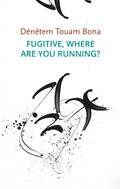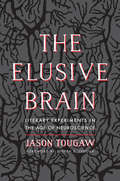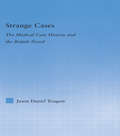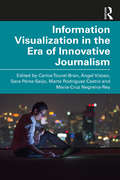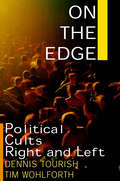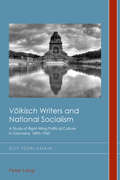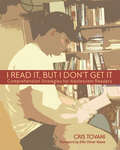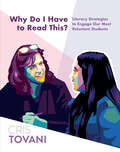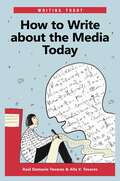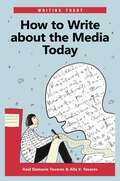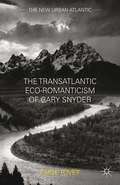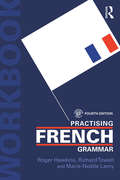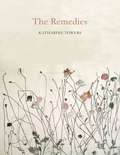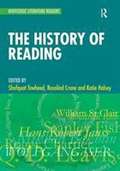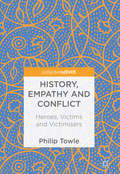- Table View
- List View
Fugitive, Where Are You Running? (Critical South)
by Dénètem Touam BonaHunting stories will usually glorify the hunters, since it is the hunters who write the stories. In this book, Dénètem Touam Bona takes up the perspective of the hunted, using the concept of marronage to highlight the lives and creativity of colonized and subjugated peoples. In a format that blends travel diary, anthropological inquiry, and philosophical and literary reflection, he narrates the hidden history of fugues – those of the runaway slave, the deserting soldier, the clandestine migrant, and all those who challenged norms and forms of control. In the space of the fugue, in the folds and retreats of dense and muggy woods, runaway countercultures appeared and spread out, cultures whose organization and values were diametrically opposed to those of colonial societies. Marronage, the art of disappearance, has never been a more timely topic: thwarting surveillance, profiling, and tracking by the police and by corporations; disappearing from databases; extending the forest’s shadow by the click of a key. In our cyberconnected world, where control of individuals in real time is increasingly becoming the norm, we need to reinvent marronage and recognize the maroon as a universal figure of resistance. Beyond its critical dimension, this book calls for a cosmo-poetics of refuge and aims at rehabilitating the power of dreams and poetry to ward off the confinement of minds and bodies.
Fugitive, Where Are You Running? (Critical South)
by Dénètem Touam BonaHunting stories will usually glorify the hunters, since it is the hunters who write the stories. In this book, Dénètem Touam Bona takes up the perspective of the hunted, using the concept of marronage to highlight the lives and creativity of colonized and subjugated peoples. In a format that blends travel diary, anthropological inquiry, and philosophical and literary reflection, he narrates the hidden history of fugues – those of the runaway slave, the deserting soldier, the clandestine migrant, and all those who challenged norms and forms of control. In the space of the fugue, in the folds and retreats of dense and muggy woods, runaway countercultures appeared and spread out, cultures whose organization and values were diametrically opposed to those of colonial societies. Marronage, the art of disappearance, has never been a more timely topic: thwarting surveillance, profiling, and tracking by the police and by corporations; disappearing from databases; extending the forest’s shadow by the click of a key. In our cyberconnected world, where control of individuals in real time is increasingly becoming the norm, we need to reinvent marronage and recognize the maroon as a universal figure of resistance. Beyond its critical dimension, this book calls for a cosmo-poetics of refuge and aims at rehabilitating the power of dreams and poetry to ward off the confinement of minds and bodies.
Deutsche Strophenformen des Mittelalters: Repertorien zur deutschen Literaturgeschichte, Band 6
by A. H. TouberThe Elusive Brain: Literary Experiments in the Age of Neuroscience
by Jason TougawFeaturing a foreword by renowned neuroscientist Joseph E. LeDoux, The Elusive Brain is an illuminating, comprehensive survey of contemporary literature’s engagement with neuroscience. This fascinating book explores how literature interacts with neuroscience to provide a better understanding of the brain’s relationship to the self. Jason Tougaw surveys the work of contemporary writers—including Oliver Sacks, Temple Grandin, Richard Powers, Siri Hustvedt, and Tito Rajarshi Mukhopadhyay—analyzing the way they experiment with literary forms to frame new views of the immaterial experiences that compose a self. He argues that their work offers a necessary counterbalance to a wider cultural neuromania that seeks out purely neural explanations for human behaviors as varied as reading, economics, empathy, and racism. Building on recent scholarship, Tougaw’s evenhanded account will be an original contribution to the growing field of neuroscience and literature.
Strange Cases: The Medical Case History and the British Novel (Literary Criticism and Cultural Theory)
by Jason TougawStrange Cases is the story of the mutual influence of the case history and the British novel during the eighteenth and nineteenth centuries. Fictions from Defoe's Roxana to James's The Turn of the Screw and case histories from George Cheyne's to Sigmund Freud's have found narrative impetus in pathology. The writer of a case history faces a rhetorical bind unique to the human sciences: the need to display the acumen of a scientist and the sympathy warranted to the suffering patient. Repeatedly, case historians justify their publicizing of extreme, often morbid or perverse, states of mind and body by appealing to readers to take pity on patients and to recognize the narrative as a vital social document. Diagnosis and sympathy, explicit rhetorical modes in case histories, operate implicitly in novels, shaping reader-identification. While these two narrative forms set out to fulfill an Enlightenment drive to classify and explain, they also raise social and epistemological questions that challenge some of the Enlightenment's most cherished ideals, including faith in reason, the perfectibility of humankind, and the stability of truth.
Strange Cases: The Medical Case History and the British Novel (Literary Criticism and Cultural Theory)
by Jason TougawStrange Cases is the story of the mutual influence of the case history and the British novel during the eighteenth and nineteenth centuries. Fictions from Defoe's Roxana to James's The Turn of the Screw and case histories from George Cheyne's to Sigmund Freud's have found narrative impetus in pathology. The writer of a case history faces a rhetorical bind unique to the human sciences: the need to display the acumen of a scientist and the sympathy warranted to the suffering patient. Repeatedly, case historians justify their publicizing of extreme, often morbid or perverse, states of mind and body by appealing to readers to take pity on patients and to recognize the narrative as a vital social document. Diagnosis and sympathy, explicit rhetorical modes in case histories, operate implicitly in novels, shaping reader-identification. While these two narrative forms set out to fulfill an Enlightenment drive to classify and explain, they also raise social and epistemological questions that challenge some of the Enlightenment's most cherished ideals, including faith in reason, the perfectibility of humankind, and the stability of truth.
Information Visualization in The Era of Innovative Journalism
by Carlos Toural-BranInformation Visualization in the Era of Innovative Journalism brings together over 30 authors from countries around the world to synthesize how recent technological innovations have impacted the development, practice and consumption of contemporary journalism. As technology rapidly progresses, shifts, and innovates, there have been immense changes in the way we communicate. This book collects research from around the world that takes an in-depth look at the primary transformations related to journalistic innovation in recent times. High-profile contributors provide cutting-edge scholarship on innovation in journalism as it relates to emergent topics such as virtual reality, podcasting, multimedia infographics, social media, mobile storytelling and others. The book pays special attention to the development of information visualization and the ability of recent innovations to meet audience needs and desires. Students and scholars studying contemporary journalism history and practice will find this a vital and up-to-date resource, as well as those studying communication technology as it relates to marketing, PR or mass media broadly.
Information Visualization in The Era of Innovative Journalism
by Carlos Toural-Bran Ángel Vizoso Sara Pérez-Seijo Marta Rodríguez-Castro María-Cruz Negreira-ReyInformation Visualization in the Era of Innovative Journalism brings together over 30 authors from countries around the world to synthesize how recent technological innovations have impacted the development, practice and consumption of contemporary journalism. As technology rapidly progresses, shifts, and innovates, there have been immense changes in the way we communicate. This book collects research from around the world that takes an in-depth look at the primary transformations related to journalistic innovation in recent times. High-profile contributors provide cutting-edge scholarship on innovation in journalism as it relates to emergent topics such as virtual reality, podcasting, multimedia infographics, social media, mobile storytelling and others. The book pays special attention to the development of information visualization and the ability of recent innovations to meet audience needs and desires. Students and scholars studying contemporary journalism history and practice will find this a vital and up-to-date resource, as well as those studying communication technology as it relates to marketing, PR or mass media broadly.
On the Edge: Political Cults Right and Left
by Dennis Tourish Tim WohlforthThis is the first book to document the extent of political cults on both the right and left and explain their significance for mainstream political organizations. The authors outline the defining characteristics of cults in general, and analyze the degree to which a variety of well-known movements fall within the spectrum of cultic organizations. The book covers such individuals and groups as Lyndon LaRouche, Fred Newman, Ted Grant, Marlene Dixon, the Christian Identity movement, Posse Commitatus, Aryan Nation, militias, and the Freemen. It explores the ideological underpinnings that predispose cult followers to cultic practices, along with the measures cults use to suppress dissent, achieve intense conformity, and extract extraordinary levels of commitment.
On the Edge: Political Cults Right and Left
by Dennis Tourish Tim WohlforthThis is the first book to document the extent of political cults on both the right and left and explain their significance for mainstream political organizations. The authors outline the defining characteristics of cults in general, and analyze the degree to which a variety of well-known movements fall within the spectrum of cultic organizations. The book covers such individuals and groups as Lyndon LaRouche, Fred Newman, Ted Grant, Marlene Dixon, the Christian Identity movement, Posse Commitatus, Aryan Nation, militias, and the Freemen. It explores the ideological underpinnings that predispose cult followers to cultic practices, along with the measures cults use to suppress dissent, achieve intense conformity, and extract extraordinary levels of commitment.
"Voelkisch" Writers and National Socialism: A Study of Right-Wing Political Culture in Germany, 18901960 (Cultural History and Literary Imagination #21)
by Guy TourlamainThis book provides a view of literary life under the Nazis, highlighting the ambiguities, rivalries and conflicts that determined the cultural climate of that period and beyond. Focusing on a group of writers – in particular, Hans Grimm, Erwin Guido Kolbenheyer, Wilhelm Schäfer, Emil Strauß, Börries Freiherr von Münchhausen and Rudolf Binding – it examines the continuities in völkisch-nationalist thought in Germany from c. 1890 into the post-war period and the ways in which völkisch-nationalists identified themselves in opposition to four successive German regimes: the Kaiserreich, the Weimar Republic, the Third Reich and the Federal Republic. Although their work predated Hitler’s National Socialist movement, their contribution to preparing the cultural climate for the rise of Nazism ensured them continued prominence in the Third Reich. Those who survived into the post-war era continued to represent the völkisch-nationalist worldview in the West German public sphere, opposing both the Soviet and liberal-democratic models for Germany’s future. While not uncontroversial, they were able to achieve significant publishing success, suggesting that a demand existed for their works among the German public, stimulating debate about the nature of the recent past and its effect on Germany’s cultural and political identity and position in the world.
"Voelkisch" Writers and National Socialism: A Study of Right-Wing Political Culture in Germany, 18901960 (Cultural History and Literary Imagination #21)
by Guy TourlamainThis book provides a view of literary life under the Nazis, highlighting the ambiguities, rivalries and conflicts that determined the cultural climate of that period and beyond. Focusing on a group of writers – in particular, Hans Grimm, Erwin Guido Kolbenheyer, Wilhelm Schäfer, Emil Strauß, Börries Freiherr von Münchhausen and Rudolf Binding – it examines the continuities in völkisch-nationalist thought in Germany from c. 1890 into the post-war period and the ways in which völkisch-nationalists identified themselves in opposition to four successive German regimes: the Kaiserreich, the Weimar Republic, the Third Reich and the Federal Republic. Although their work predated Hitler’s National Socialist movement, their contribution to preparing the cultural climate for the rise of Nazism ensured them continued prominence in the Third Reich. Those who survived into the post-war era continued to represent the völkisch-nationalist worldview in the West German public sphere, opposing both the Soviet and liberal-democratic models for Germany’s future. While not uncontroversial, they were able to achieve significant publishing success, suggesting that a demand existed for their works among the German public, stimulating debate about the nature of the recent past and its effect on Germany’s cultural and political identity and position in the world.
I Read It, but I Don't Get It: Comprehension Strategies for Adolescent Readers
by Cris TovaniI Read It, but I Don't Get It: Comprehension Strategies for Adolescent Readers is a practical and engaging account of how teachers can help adolescents develop new reading comprehension skills. Cris Tovani is an accomplished teacher and staff developer who writes with verve and humor about the challenges of working with students at all levels of achievement-;from those who have mastered the art of fake reading to college-bound juniors and seniors who struggle with the different demands of content-area textbooks and novels. Enter Tovani's classroom, a place where students are continually learning new strategies for tackling difficult text. You will be taken step-by-step through practical, theory-based reading instruction that can be adapted for use in any subject area. The book features: Anecdotes in each chapter about real kids with real universal problems. You will identify with these adolescents and will see how these problems can be solvedA thoughtful explanation of current theories of comprehension instruction and how they might be adapted for use with adolescentsA What Works section in each of the last seven chapters that offers simple ideas you can immediately employ in your classroom. The suggestions can be used in a variety of content areas and grade levels (6-12)Teaching tips and ideas that benefit struggling readers as well as proficient and advanced readersAppendixes with reproducible materials that you can use in your classroom, including coding sheets, double entry diaries, and comprehension constructorsIn a time when students need increasingly sophisticated reading skills, this book will provide support for teachers who want to incorporate comprehension instruction into their daily lesson plans without sacrificing content knowledge.
I Read It, but I Don't Get It: Comprehension Strategies for Adolescent Readers
by Cris TovaniI Read It, but I Don't Get It: Comprehension Strategies for Adolescent Readers is a practical and engaging account of how teachers can help adolescents develop new reading comprehension skills. Cris Tovani is an accomplished teacher and staff developer who writes with verve and humor about the challenges of working with students at all levels of achievement-;from those who have mastered the art of fake reading to college-bound juniors and seniors who struggle with the different demands of content-area textbooks and novels. Enter Tovani's classroom, a place where students are continually learning new strategies for tackling difficult text. You will be taken step-by-step through practical, theory-based reading instruction that can be adapted for use in any subject area. The book features: Anecdotes in each chapter about real kids with real universal problems. You will identify with these adolescents and will see how these problems can be solvedA thoughtful explanation of current theories of comprehension instruction and how they might be adapted for use with adolescentsA What Works section in each of the last seven chapters that offers simple ideas you can immediately employ in your classroom. The suggestions can be used in a variety of content areas and grade levels (6-12)Teaching tips and ideas that benefit struggling readers as well as proficient and advanced readersAppendixes with reproducible materials that you can use in your classroom, including coding sheets, double entry diaries, and comprehension constructorsIn a time when students need increasingly sophisticated reading skills, this book will provide support for teachers who want to incorporate comprehension instruction into their daily lesson plans without sacrificing content knowledge.
Why Do I Have to Read This?: Literacy Strategies to Engage Our Most Reluctant Students
by Cris TovaniWhy do I have to read this?- What teacher doesn't dread this question? It usually comes from our most disengaged students a student who cries of boredom, or one who is angry or apathetic. When we don't know what else to try, it's easy to become frustrated and give up on these challenging learners. Author Cris Tovani has spent her career figuring out how to entice challenging students back into the process of learning. Why Do I Have to Read This?: Literacy Strategies to Engage our Most Reluctant Students Tovani shares her best secrets, lessons learned from big fails, and her most effective literacy and planning strategies that hook these hard to get learners. You will meet many of Tovani's students inside this book. As she describes some of her favorites, you may even recognize a few of your own. You will laugh at her stories and take comfort in her easily adaptable strategies that help students remove their masks of disengagement. She shows teachers how to plan by anticipating students' needs. HerC urriculumY ouA nticipate structures of Topic, Task, Targets, Text, Tend to me, and Time willhelp you anticipate your curriculum. InsideWhy Do I Have to Read This? readers will find: Literacy strategies for all content areas that support and engage a wide range of learners so they can read and write a variety of complex textReference charts packed with small bites of instructional shifts that coaches and teachers can use to quickly adjust instruction to re-engage studentsPlanning strategies that show teachers how to connect day-to-day instruction so that no day lives in isolationVersatile think sheets that are reproducible and adaptable to different grade levels, content areas, and disciplinesAbove all, Tovani gives teachers energy to get back into the classroom and face students who wear masks of disengagement. She reminds us of the importance of connecting students to compelling topics, rich text, useful targets, and worthy tasks. Teachers must tendto students' basic needs and helps us consider how to best structure instructional time.After reading this book, teachers will have new ways to connect with students in a deep, authentic way. Written in a humorous, compassionate, and wise voice,Why Do I Have to Read This? will provide answers to the pressing questions we have when we try to teach and reach all of our students.
Why Do I Have to Read This?: Literacy Strategies to Engage Our Most Reluctant Students
by Cris TovaniWhy do I have to read this?- What teacher doesn't dread this question? It usually comes from our most disengaged students a student who cries of boredom, or one who is angry or apathetic. When we don't know what else to try, it's easy to become frustrated and give up on these challenging learners. Author Cris Tovani has spent her career figuring out how to entice challenging students back into the process of learning. Why Do I Have to Read This?: Literacy Strategies to Engage our Most Reluctant Students Tovani shares her best secrets, lessons learned from big fails, and her most effective literacy and planning strategies that hook these hard to get learners. You will meet many of Tovani's students inside this book. As she describes some of her favorites, you may even recognize a few of your own. You will laugh at her stories and take comfort in her easily adaptable strategies that help students remove their masks of disengagement. She shows teachers how to plan by anticipating students' needs. HerC urriculumY ouA nticipate structures of Topic, Task, Targets, Text, Tend to me, and Time willhelp you anticipate your curriculum. InsideWhy Do I Have to Read This? readers will find: Literacy strategies for all content areas that support and engage a wide range of learners so they can read and write a variety of complex textReference charts packed with small bites of instructional shifts that coaches and teachers can use to quickly adjust instruction to re-engage studentsPlanning strategies that show teachers how to connect day-to-day instruction so that no day lives in isolationVersatile think sheets that are reproducible and adaptable to different grade levels, content areas, and disciplinesAbove all, Tovani gives teachers energy to get back into the classroom and face students who wear masks of disengagement. She reminds us of the importance of connecting students to compelling topics, rich text, useful targets, and worthy tasks. Teachers must tendto students' basic needs and helps us consider how to best structure instructional time.After reading this book, teachers will have new ways to connect with students in a deep, authentic way. Written in a humorous, compassionate, and wise voice,Why Do I Have to Read This? will provide answers to the pressing questions we have when we try to teach and reach all of our students.
How to Write about the Media Today (Writing Today)
by Raúl Damacio Tovares Alla V. TovaresA comprehensive and practical guide to writing a successful media paper or report, from selecting a topic to submitting the final draft.How to Write about the Media Today is the first book to offer students and media practitioners a comprehensive approach for researching and preparing a report, paper, or presentation on some aspect of today's mass communication. How to Write about the Media Today begins with a discussion of different types of media outlets—from traditional newspapers and television to the Internet—as well as an overview of contemporary directions in media studies. This is followed by a series of step-by-step strategies for selecting topics, conducting research, and writing cogently and engagingly about media-related events and issues. Because each chapter stands on its own, this resource can be read sequentially or consulted topic-by-topic as needed.
How to Write about the Media Today (Writing Today)
by Raúl Damacio Tovares Alla V. TovaresA comprehensive and practical guide to writing a successful media paper or report, from selecting a topic to submitting the final draft.How to Write about the Media Today is the first book to offer students and media practitioners a comprehensive approach for researching and preparing a report, paper, or presentation on some aspect of today's mass communication. How to Write about the Media Today begins with a discussion of different types of media outlets—from traditional newspapers and television to the Internet—as well as an overview of contemporary directions in media studies. This is followed by a series of step-by-step strategies for selecting topics, conducting research, and writing cogently and engagingly about media-related events and issues. Because each chapter stands on its own, this resource can be read sequentially or consulted topic-by-topic as needed.
The Transatlantic Eco-Romanticism of Gary Snyder (The New Urban Atlantic)
by Paige ToveyTracing connections between Gary Snyder and his Romantic and Transcendentalist predecessors - Wordsworth, Blake, Emerson, Whitman, and Thoreau - this study explores the tension between urbanization and overindustrialization. The dialectical relationship between Snyder and his predecessors reminds readers that nature is never a simple concept.
Practising French Grammar: A Workbook
by Richard Towell Marie-Noelle Lamy Dr Roger HawkinsThis new edition of Practising French Grammar offers a set of varied and accessible exercises for developing a practical awareness of French as it is spoken and written today. The lively examples and authentic texts and cartoons have been updated to reflect current usage. A new companion website provides a wealth of additional interactive exercises to help consolidate challenging grammar points. Practising French Grammar provides concise summaries of key grammatical points at the beginning of each exercise, as well as model answers to the exercises and translations of difficult words, making it ideal for both in-class use and independent study. It can be used alone or as the ideal companion to the fourth edition of French Grammar and Usage.
Practising French Grammar: A Workbook (Practising Grammar Workbooks Ser.)
by Richard Towell Marie-Noelle Lamy Dr Roger HawkinsThis new edition of Practising French Grammar offers a set of varied and accessible exercises for developing a practical awareness of French as it is spoken and written today. The lively examples and authentic texts and cartoons have been updated to reflect current usage. A new companion website provides a wealth of additional interactive exercises to help consolidate challenging grammar points. Practising French Grammar provides concise summaries of key grammatical points at the beginning of each exercise, as well as model answers to the exercises and translations of difficult words, making it ideal for both in-class use and independent study. It can be used alone or as the ideal companion to the fourth edition of French Grammar and Usage.
The Remedies
by Katharine TowersKatharine Towers' second collection is a book of small wonders. From a house drowning in roses to crickets on an August day, from Nerval's lobster to the surrealism of flower remedies, these poems explore the fragility of our relationship with the natural world. Towers also shows us what that relationship can aspire to be: each poem attunes us to another aspect of that world, and shows what strange connections might be revealed when we properly attend to it. The Remedies is a lyric, unforgettable collection which offers just the spiritual assuagement its title promises, and shows Towers emerging as a major poetic talent.
The History of Reading: A Reader (PDF)
by Shafquat Towheed Rosalind Crone Katherine HalseyThe History of Reading offers an engaging, accessible overview from the rise of literacy through to the current trend of ‘book clubs’. Divided into seven sections, each with a useful introduction, this Reader: summarises the main debates and perspectives shaping the field introduces key theorists such as Iser, Fish and Bakhtin surveys influential works and outlines important studies on mass reading focuses on specific communities such as Welsh miners, African American library users and Australian convicts looks at individual readers from a variety of countries, classes and historical periods considers current research in the history of reading. Providing both a clear introduction to the history of the field and a taster of the breadth, diversity and vitality of current debates, this Reader is an essential resource for undergraduates, graduates, and researchers.
History, Empathy and Conflict: Heroes, Victims and Victimisers
by Philip TowleThis book argues that popular culture has been transformed in a silent revolution from emphasising history’s heroes to its victims. While city squares and stations were named in the nineteenth century after military victories, now the equivalent airports are named after the victims of violence. Where war reports used to focus on the leadership of the generals and the bravery of the troops, now they are mostly about casualties, refugees and destruction. History, Empathy and Conflict examines the diplomatic consequences of such a revolution in sensibility. Many governments have responded by apologising for their country’s historic actions. History teaching in schools has sometimes been revised to reflect the new emphasis and to build confidence between nations and respect for domestic minorities. Not least of the reasons for these changes is the difficulty or impossibility of making restitution for past wrongs. But history can also be used by the media and governments to justify intervention to protect victims of civil wars only to come to be seen as victimisers themselves. The past is always difficult to interpret but is the basis of all our decisions and all institutions try to twist it to their own convenience. Sympathy with history’s victims is a great moral advance but it can be used by dissatisfied nations to justify their revisionist policies and with the election of President Trump in 2016, all the Great Powers claim to be history’s victims.
History, Empathy and Conflict: Heroes, Victims and Victimisers
by Philip TowleThis book argues that popular culture has been transformed in a silent revolution from emphasising history’s heroes to its victims. While city squares and stations were named in the nineteenth century after military victories, now the equivalent airports are named after the victims of violence. Where war reports used to focus on the leadership of the generals and the bravery of the troops, now they are mostly about casualties, refugees and destruction. History, Empathy and Conflict examines the diplomatic consequences of such a revolution in sensibility. Many governments have responded by apologising for their country’s historic actions. History teaching in schools has sometimes been revised to reflect the new emphasis and to build confidence between nations and respect for domestic minorities. Not least of the reasons for these changes is the difficulty or impossibility of making restitution for past wrongs. But history can also be used by the media and governments to justify intervention to protect victims of civil wars only to come to be seen as victimisers themselves. The past is always difficult to interpret but is the basis of all our decisions and all institutions try to twist it to their own convenience. Sympathy with history’s victims is a great moral advance but it can be used by dissatisfied nations to justify their revisionist policies and with the election of President Trump in 2016, all the Great Powers claim to be history’s victims.
